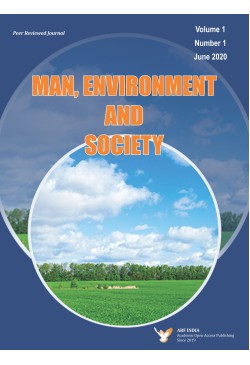
Man, Environment and Society
Frequency :Bi-Annual
ISSN :2582-7669
Peer Reviewed Journal
ANCESTOR CULT AND ITS SIGNIFICANCE IN AGRICULTURAL ACTIVITIES OF DOKO COMMUNITY OF GAMO HIGH LANDS OF ETHIOPIA
C. Subba Reddy (2022). Ancestor Cult and its Significance in Agriculture Activities of Duko Community of Gamo High Lands of Ethiopia. Man, Environment and Society, Vol. 3, No. 2, pp. 235-248. https://DOI:10.47509/MES.2022.v03i02.01
NATURE, IMPLEMENTATION AND OUTPUT OF PUBLIC WORK PROGRAMMES BEFORE AND AFTER MGNREGA INITIATION IN INDIA
Prashant Bhimrao Dongardive & Abhiman Nagdeve (2022). Nature, Implementation and Output of Public Work Programmes before and after MGNREGA Initiation in India. Man, Environment and Society, Vol. 3, No. 2, pp. 249-267. https://DOI:10.47509/MES.2022.v03i02.02
ANTHROPOLOGY IN ARCHITECTURAL RESEARCH: PAST, PRESENT AND PROSPECT
Arghya Santra (2022). Anthropology in Architectural Research: Past, Present and Prospect. Man, Environment and Society, Vol. 3, No. 2, pp. 269-280. https://DOI:10.47509/MES.2022.v03i02.03
DETERMINANTS OF HOSPITALISATION OF COVID-19 PATIENTS: A TWO-YEAR RETROSPECTIVE STUDY AT AN INFECTIOUS DISEASE HOSPITAL IN BULAWAYO, ZIMBABWE
FERTILITY AND MORTALITY DIFFERENTIALS AMONG THE HIGH AND LOW ALTITUDE MONPA OF ARUNACHAL PRADESH
SOCIO-CULTURAL FACTORS IN HEALTH CARE PRACTICES OF WOMEN AMONG THE LOIS OF MANIPUR- AN ANTHROPOLOGICAL STUDY